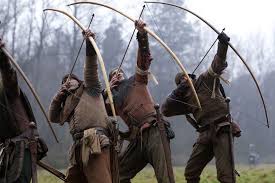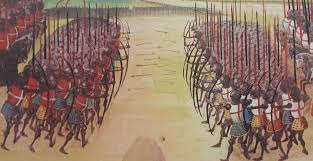Your basket is currently empty!
Introduction: The Weapon That Defined English Warfare
The British longbow, also known as the English longbow, is one of the most iconic weapons in medieval history. Revered for its deadly range, power, and speed, the longbow played a crucial role in major battles such as Crecy (1346), Poitiers (1356), and the legendary Battle of Agincourt (1415). It transformed English military strategy and turned peasant archers into decisive war heroes. But how did this bow become such a feared tool of war?
Origins of the British Longbow
Though long-range bows existed earlier, the true longbow rose to prominence in 13th-century Wales and was later adopted and perfected by the English. Made typically from yew wood, a finished longbow could be as tall as the archer who wielded it—around 6 feet. Its range and force made it ideal for piercing armor, especially when used in volleys by trained archers. By the reign of Edward I, the longbow became a formal part of England’s military doctrine.
Design and Power: A Bow Unlike Any Other
The British longbow wasn’t just long—it was incredibly powerful. Draw weights often exceeded 100–150 pounds, requiring years of training and strength. A skilled archer could shoot 10–12 arrows per minute, each capable of traveling over 250 yards. These arrows were tipped with bodkin points to pierce armor or broadheads for maximum damage against infantry and horses. The simplicity of its design made it reliable in all weather and terrain.
Longbowmen: England’s Secret Weapon
English longbowmen weren’t just soldiers—they were specialists. Boys trained from an early age to master the bow, with archery practice mandated by law during the 14th and 15th centuries. Archers formed the backbone of English armies, often positioned on the flanks and protected by wooden stakes to fend off cavalry. Their disciplined volleys disrupted enemy formations before melee combat even began, giving English forces a consistent upper hand.
The Longbow’s Role in Key Battles

⚔️ Battle of Crécy (1346)
English archers devastated the French cavalry, marking the rise of infantry dominance in warfare.
⚔️ Battle of Poitiers (1356)
Another English victory where longbowmen played a central role in defeating a larger French force.
⚔️ Battle of Agincourt (1415)
Perhaps the longbow’s most famous moment, where King Henry V’s smaller army overcame overwhelming odds, killing thousands of heavily armored French knights.
In all these battles, the longbow was the decisive factor—proving superior to the more expensive and prestigious knightly cavalry.
Decline and Legacy of the Longbow
As gunpowder weapons and cannons emerged in the 16th century, the longbow’s dominance faded. However, its impact on European warfare was already profound. It marked a shift away from elite, noble warriors toward mass infantry supported by training and technology. Today, the longbow is remembered as a symbol of English military ingenuity, featured in films, museums, and reenactments across the UK.
Historical Myths vs. Facts
-
Myth: The longbow could pierce any armor.
✅ Truth: It could penetrate chainmail and plate armor at close range, but not always at long distance. -
Myth: Only nobles used longbows.
✅ Truth: Most longbowmen were commoners—proof that skill and training could surpass noble status on the battlefield.
Conclusion: The British Longbow’s Lasting Impact
The British longbow wasn’t just a weapon—it was a revolution in military strategy. Its use redefined medieval warfare, empowered common soldiers, and reshaped the battlefield forever. For over two centuries, it stood as a symbol of English resilience, discipline, and deadly efficiency. Whether you’re a history lover or medieval warfare enthusiast, the story of the longbow remains one of innovation and triumph.
Explore more historical war machines on our War Machines site.

